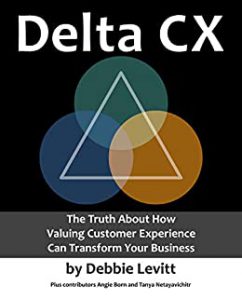
A review of
Delta UX: The Truth About How Valuing Customer Experience Can Transform Your Business
by Debbie Levitt and contributing authors: Angie Born, Tanya Netayavichitr
Book Website Publisher: Self published by the author 379 pages, 4 partsAbout this book
A good reference for Methods/How-To and UX Theory Primary audience: Researchers, Designers, Technical Roles Level: New to topic (less than 1 year), Some experience with topic (1-4 years), Significant experience with topic (More than 4 years) Writing style: Matter-of-fact, Humorous Text density: Mostly text Learn more about our book review guidelines [/greybox] This book does exactly what it says on the tin. It tells the truth! Author Debbie Levitt and her colleagues have written a book that is a call to arms to Customer Experience (CX) designers and everyone else who is or wants to be instrumental in improving the products, services and experiences (PSE) at their companies. Customer Experience as described by the authors ‘represent all of the experiences a potential or current customer can have with a brand or company including products, services, physical locations digital products, and systems.’ CX is hard to achieve. This book aspires to help readers better understand the need to have a strategy behind CX. It provides advice on how an organisation can invest in the right set of people, processes and practices to build products that are customer focused. The book raises some big questions about how the UX/CX industry has grown (or regressed in some instances) and the need for us, as CX professionals, to hold on tight to our research backed processes, because quite simply, they have been ‘proven to work’. ‘Delta CX model is for everybody’ – The book begins with this subtitle and it is evident throughout, as it presents ideas with a humorous and matter of fact tone without the overuse of jargon, making it accessible for non-professionals as well. What comes through quite clearly in the book is that Ms Levitt is very experienced in the software development field. She has worked in a variety of companies, collaborating with a wide variety of stakeholders who represent both the business and engineering sides in companies. She has definitely seen it all and her ‘say it like it is’ tone throughout the book makes one feel that this is a book to really get your teeth into. Each of the four parts of the book goes into detail with key concepts and ideas using a mix of interviews, stories and case studies to cater to a mixed audience. The author explicitly states that the book will not provide any checklists or templates but it does provide real life stories and case studies to explain how and when methods and techniques can be used. We are introduced to the core principles and critical thinking behind the Delta CX model in the first part of the book.The model is offered as an alternative to the current trends which have gained popularity and in some cases notoriety in the industry. The book brings to focus a series of books that ‘were released that sought to move companies away from investing in customer research and design, and towards methods promising dramatically faster solutions “designed” by a cross functional project team’. The author dissects them in a real and honest way. This section will also be especially important to those wanting to find out more about the field, as it provides an honest review of the popular trends. The second part of the book deals with how an organisation can actually achieve a transformational customer experience. The book goes into the nitty gritty details of hiring professional CX practitioners (i.e. people who are actually trained in the field), how their roles can be defined within the organisation, and how the right type of culture within the organisation can let them thrive. This section also provides details on putting together a CX strategy and how a great CX team can be empowered to become an organisation’s competitive advantage. This is an insightful section in the book, especially for individuals in business management and human resources, as it pays attention to the rather daunting task of hiring the right people. Not all designers are the same even though they might be called designers! This section very clearly provides information on what recruiters need to look out for in order to not only bring in the best, but also to keep them. The author goes on to share her experience on how CX professionals can collaborate and fit into software development in the third part of the book. It presents a slightly modified user centred design (UCD) process that covers the importance of being grounded in proper research. Again, an important section of the book as it stresses on the need to be rigorous right from the beginning – gathering requirements all the way up to documentation. Having a strategy around content or even just analysing the content can easily become an afterthought. The modified version of the UCD process presented in the book includes content analysis,strategy, and information architecture. This section also holds a lens to reexamine the necessity of certain common tasks undertaken such as stakeholder interviews, tips on how to handle situations when speaking to users is not possible as well as some thoughts on using design systems and style guides. The author also provides valuable tips on how the Delta CX model fits into agile software development. She examines popular beliefs around agile development and provides a convincing argument for the way in which the CX process is involved right in the beginning of the agile process. This section also provides very detailed thoughts on collaboration, seeing it as a way for CX professionals to actually work together with various teams within an organisation rather than just as a coach or facilitator. The author also provides detailed tips on how CX professionals can ‘collaborate with respect’. The fourth and final part of the book covers evangelism or the need to stop doing it. UX evangelism has become an important part of the job but the author presents very strong reasons behind her stance. Selling UX as easy tasks at conferences and simplified courses that certify non-professionals harm the perceptions of the field. Instead, she provides tips on how to really sell UX by being truly collaborative and cross-functional when working on CX projects. This section of the book also has some invaluable advice for CX leadership that would help teams build a culture for doing great CX work within organisations. It also emphasises the need of undertaking professional training from recognised and accredited institutions that have a proven track record of training in CX in an effort to uphold our rather important profession. Nielsen Norman Group, ‘the original and current thought leaders’ in the field and the UXDesignInstitute.com are recommended. In keeping with the overall theme in the book, this section also particularly busts very common myths about the CX profession and the skills that are necessary to become CX professionals. In summary, reading Delta CX felt like talking to a UX mentor. The authors generously share their experience, tips, and advice in a thoughtful and no-nonsense way. The book has gumption. It’s definitely a book I will read again cover to cover but perhaps also dip into midway through a project! [bluebox] The Business Value of Design Most of us in the CX world are tired of hearing that we have to prove the business value of design. We can quote so many famous Apple, IBM, and other leaders about the importance and value of design; why do so many companies still not get it? Even the companies producing those great quotes don’t always get it. Apple has its share of confusing interfaces. People have cheered the discontinuation of certain Apple software. They had batteries that exploded and antennas that didn’t work, and they blamed customers at first. Apple’s 2019 MacBook Pros were clocked as having a slower SSD than the 2018 model. People believed this was to keep costs down, but who wants a laptop that’s slower than last year’s model? While we have endless examples from nearly every company on the planet, we still have to make the business case for CX. We still have to make the business case for proper customer research and designing more for them than what some stakeholders assume people will want. We still have to fight against organizations that are more proud of speed than they are of quality, and who might not even be measuring customer satisfaction beyond, “Press 9 on your phone if you were happy with the rep you spoke today.” This book is aimed at giving you ammunition for these discussions. [/bluebox]Revathi Nathaniel has 16 years of experience as a usability expert and user researcher. She has experience working with companies that build enterprise software, SQL products, and non-profit scientific organizations. She enjoys working with multidisciplinary teams that work collaboratively to solve complex problems and continuously improve the user’s experience of software applications.

